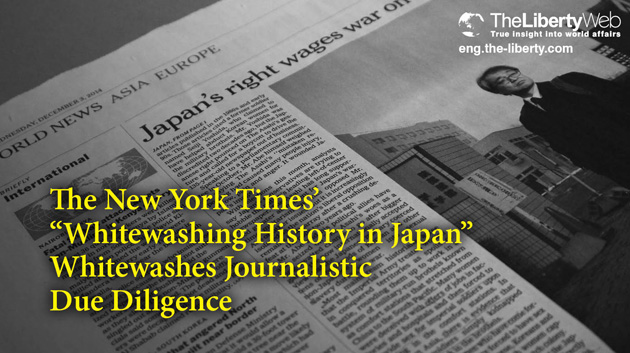The New York Times’ “Whitewashing History in Japan” Whitewashes Journalistic Due Diligence
The International edition of the New York Times recently published an article titled “Whitewashing History in Japan“, written based on an interview from a former Asahi Shimbun reporter named Takashi Uemura.
Predictably, the narrative was heavily one-sided and based on the premise that the Japanese military forced sexual slavery upon people known as comfort women. Uemura responded to the criticisms launched against him and the Asahi Shimbun by saying that “they want to bully us into silence”. The article went on to paint the Abe administration and the Japanese right wing as historical revisionists intent on overturning the 1993 apology issued in the Kono Statement.
Primary source information was also missing from the article regarding the facts behind the issue. Instead, the article simply regurgitated what others have claimed about the comfort women.
The only evidence that the article provided to back up the narrative of forced prostitution was the words of the alleged, former comfort women. The author failed to submit any additional primary source materials. Earlier this year, the Asahi Shimbun apologized for reporting as fact without performing any background checks Seiji Yoshida’s discredited claims that he “forced comfort women into enslavement”. Perhaps the New York Times hasn’t yet learned the folly of reporting without due diligence.
What the New York Times article failed to mention was primary source information, such as the Interagency Working Group’s (IWG) report on Nazi and Japanese war crimes, which it submitted to Congress in 2007. After spending 30 million dollars to go through over 8.5 million newly declassified documents, opened to the public under the Nazi War Crimes Disclosure Act and the Japanese Imperial Government Disclosure Act, the IWG was unable to find any evidence that gave credence to the claims of forced prostitution by the Japanese government or military. In fact, the report goes on to give an apology to the special interest groups who were eagerly looking forward to such evidence.
Furthermore, “Report 49″ provided by the United States Office of War Information (OWI) in 1944 described the interview of 20 captured Korean comfort women. The report clearly identified them as paid prostitutes instead of sex slaves, and went onto describe how they participated “in sports events with both officers and men, and attended picnics, entertainments, and social dinners”.
The primary source documents clearly noted that the comfort women were highly paid prostitutes.
Interestingly, a group of South Korean women recently sued their government saying that U.S. forces in South Korea treated them as comfort women. While the U.S. media immediately responded by saying that they were prostitutes, those same media outlets have continued to refer to those comfort women, who had served the Japanese military, as sex slaves.
Both Japanese and U.S. military bases, during their respective times, had “comfort stations” where men paid for sex with prostitutes. But curiously enough, those same prostitutes became “sex slaves” in name when served the Japanese military.
Perhaps it’s time for both the Japanese and Western media to return to primary source research and to deliver the real story.



















